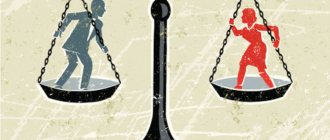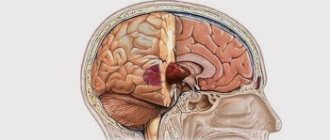Each of us, at least once in our lives, found ourselves in the company of interesting personalities who, during a conversation, used some very smart, but not always understandable words and phrases. “Cognitive dissonance” precisely belongs to the category of those concepts that many people often use, but do not always understand what exactly their meaning is.
At school we all studied Krylov's fables. One of the fables, in which we are talking about a gossamer fox and grapes, demonstrates to us in the best possible way what cognitive dissonance really is. The sly fox, seeing a juicy bunch of grapes in the garden, wanted to eat the delicious berries. But no matter how she tried to get to the grapes, she never succeeded.
In despair, the fox said to herself with annoyance that although the grapes looked good, she didn’t see a single ripe berry, so she didn’t really want to eat them, because it could immediately set the teeth on edge. Lisa experienced first-hand the cognitive dissonance that arose when she was unable to satisfy her desire.
What is cognitive dissonance in simple words? When and why did the theory of cognitive dissonance emerge? What is the essence of this concept? What state is a person experiencing cognitive dissonance in? How does our consciousness fight this unpleasant state? In this article we will look at these and other questions regarding cognitive dissonance and its impact on our daily lives!
Cognitive dissonance: what is it in simple words?
Cognitive dissonance (translated from Latin “cognitio” - “cognitive process”, “cognition”, “recognition” and “dissonantia” - “lack of harmony”, “lack of consonance”, “lack of coherence”, “inconsistency”) is a specific condition mental discomfort of the individual, which occurs when conflicting values, ideas, emotional reactions, beliefs and other ideas about the surrounding reality or one’s own inner world collide in a person’s mind.
If we talk about cognitive dissonance in simple words, this phenomenon can be described as a conflict that arises within a person. Each of us imposes a certain pattern on this or that event occurring in our lives in the form of a previously created model of behavior or attitude. We do this on a subconscious level in order to create more convenient and comfortable conditions for everyday existence.
What emotions will you experience if you see that a beggar man in torn clothes, to whom you gave twenty rubles a few minutes ago, gets behind the wheel of a luxury SUV? How would you feel if you found out that your quiet, friendly, always level-headed acquaintance hit his wife? You will experience a breakdown or breakdown of the previously established pattern and you, plunging into a state close to shock or stupor, will begin to experience psychological discomfort (dissonance).
Cognitive dissonance by default causes discomfort in any person, so it is not surprising that each of us, having plunged into this state, strives to get out of it as quickly as possible. One category of people prefers to ignore, another category tries to resolve a conflict situation, a third category simply does not notice what is happening around them, and a fourth category tries in every possible way to avoid plunging into a state of cognitive dissonance.
The main problem caused by the state of cognitive dissonance is that a person experiencing internal discomfort is not searching for the truth, but is trying to formally bring motives and knowledge to a common denominator. That is why many people, trying to get rid of internal contradictions, use the first excuse that comes to mind, which is more or less suitable in a given situation.
[edit] See also
- Buthurt
- Wash your brain
- Schizophasia
- What were you smoking?
- Division by zero
- Break pattern
- I don't understand shit
- Mutually exclusive paragraphs
| [ + ] Cognitive dissonance - material from the archives of the Ministry of Health of Lurkomor. | |||||||||||||||
| |||||||||||||||
When and why did the theory of cognitive dissonance emerge?
Leon Festinger
In 1957, American psychologist and expert in the field of psychology of thought regulation Leon Festinger, taking as a basis Heider's theory of structural balance and Lewin's field theory, formulated the theory of cognitive dissonance. The impetus for the creation of the theory was the rumors that spread after the earthquake in one of the American states. Festinger, wanting to explain both the rumors and the sincere belief in them by many US residents, made the following conclusion: people always strive for internal balance between personal motives that determine their behavior and information received from outside.
Before Leon Festinger, virtually no scientists had studied the motivational process and its cognitive components at a serious level. He was able to prove that any person strives to make his perception of the real world coherent and orderly.
Every person wants not only to know inner harmony, but also to preserve it. All views and attitudes that are inherent in a particular person are combined into a system, all the elements of which are consistent with each other. Almost similar agreement exists between what a person believes and how he acts.
Festinger formulated two hypotheses of his theory. The first hypothesis states that a person experiencing cognitive dissonance will do everything possible to reduce the level of incongruity between conflicting attitudes. Since the individual does not want to experience mental discomfort, he strives as quickly as possible to ensure that correspondence (consonance) arises between conflicting attitudes.
The second hypothesis is as follows: “A person experiencing cognitive dissonance not only strives to establish correspondence between conflicting attitudes, but in the future will also begin to actively avoid information and life situations that may cause such a state or increase its level.”
What is the essence of the theory of cognitive dissonance?
The theory of cognitive dissonance can rightly be called a motivational theory. Cognitive dissonance as a condition significantly influences the behavior of an individual. A set of certain beliefs, values, beliefs, ideas and other cognitions that are inherent in every person affects not only his actions and actions, but also his life position and internal philosophy.
Cognitions are of two types: those that determine a person’s inner world and his ideas about himself and those that determine a person’s relationship to the external world and the reality surrounding him.
Some experts argue that cognition is just a set of certain facts. But the theory of cognitive dissonance proves that this statement is not true. Cognitions are those motivational factors that determine an individual’s behavior both in everyday life and in extreme or non-standard life situations.
Cognitive dissonance theory consists of two elements: intelligence and affect. Intelligence is a set of certain knowledge and beliefs, and affect is a reaction to stimuli and stimuli. At those moments when a person begins to feel internal contradictions between these elements or ceases to find a connection between them, he plunges into a state of cognitive dissonance.
This process has a certain connection with acquired experience or events from the past. Having acted in a certain way or performed a certain action, after some time a person may not only begin to feel remorse or repent of his action, but also look for an excuse for himself.
The theory created by Leon Festinger is confirmed by experiments, studies and tests of brain activity carried out on a tomograph. During one of the experiments, conditions were created for the study participant to experience simple cognitive dissonance. The subject was shown a piece of red paper several times, but a completely different color was named out loud. At the same time, his brain activity was scanned on a tomograph.
The results of the experiment confirmed the fact that when cognitive dissonance occurs, the cingulate cortex, which is responsible for switching attention, identifying errors and inconsistencies, monitoring conflict situations, and controlling certain types of activity, is activated.
When the conditions became more complicated and the experiment participant began to be given more contradictory and complex tasks, the scientists were able to prove that the less the volunteer finds excuses for his actions, the more the cingulate cortex of his brain is excited and the more tension he begins to experience.
The main causes of cognitive dissonance
There are many reasons why cognitive dissonance occurs. Let's look at the most popular and widespread of them.
A person can plunge into a state of cognitive dissonance when there is a discrepancy between concepts and ideas that have a strong influence on him when making certain decisions. This is the first and most common cause of internal conflict.
The second reason is the discrepancy that arises between the life beliefs of an individual and the generally accepted norms that guide society or people of a certain circle.
The third reason is the spirit of contradiction. This phenomenon occurs when a person does not want to obey generally accepted ethical and cultural norms. The situation can become heated if these standards do not comply with the law.
The fourth reason is inconsistency, which occurs when information obtained as a result of a certain life experience contradicts new life situations or conditions.
How to solve
Cognitive dissonance can be alleviated or completely eliminated in several ways. First, it is worth clarifying that dissonance can be either an intrapersonal contradiction or an intergroup contradiction or between a group and an individual. So what can you do:
- Accepting your actions (or the actions of the group) and changing personal beliefs (changing your attitude towards the situation).
- Changing the environment (break up with friends if their behavior does not correspond to your beliefs).
- Changing your own behavior according to previous attitudes.
However, it is not enough to want to overcome the contradiction. On the path to psychological harmony, a number of factors may arise that impede this:
- losses from behavior changes (withdrawal when getting rid of addiction, financial losses when changing jobs with a tyrant boss, but with good pay);
- an ambivalent attitude towards one’s own behavior or the need to change the situation (the food in the cafe has become bad, but you don’t want to part with your friends, and they, in turn, don’t want to change the location);
- the impossibility of changing behavior (often a contradiction arises against the background of temperamental characteristics (mental properties) that cannot be changed, or other psychophysiological characteristics);
- the impossibility of changing external circumstances, the environment (for example, you regret selling your house, but the new owner does not want to enter into a reverse transaction).
If it is impossible to change the conditions of a life task, then all that remains is to change your attitude. “If you can’t change the situation, change your attitude towards it.” Is this a familiar phrase? This is the way to achieve internal harmony. Well, if you can change the situation, then change it!
Vivid examples of the state of cognitive dissonance from everyday life
Example No. 1. Nikolai and parental authority
Nikolai is a quiet and obedient boy of primary school age, for whom any word from his father or mother is the law and the ultimate truth. Kolya understands perfectly well that good children listen to their parents and never question their authority.
Therefore, there is nothing strange in the fact that the boy experienced cognitive dissonance when his dad first told him that it was absolutely forbidden to cross the road when the traffic light was red, otherwise he could get hit by a car and get seriously injured, and a few days later he and his son crossed the road when the light was red light, because he was in a hurry and did not wait for the light to turn green.
The boy found himself in the same state of psychological discomfort when he heard that his mother, who always told him that he should never take someone else’s property, was telling his dad that she had managed to secretly smuggle several packs of printer paper through the entrance.
Children, unlike adults, when experiencing cognitive dissonance, receive tangible psychological trauma, which leaves an imprint on the rest of their lives. A child whose psyche has not yet strengthened cannot cope with the discrepancy that has arisen between what his parents told him and what he saw with his own eyes.
Example No. 2. Nadezhda and her move to another country
Nadezhda never wanted to leave her hometown, but meeting a charismatic foreigner influenced her fate in the most dramatic way. When her beloved invited Nadya to marry him and leave for his native country, the girl did not think for a second that she was an Orthodox Christian, and her future husband was a devout Muslim.
Having gotten married, the newlyweds left for the young man’s homeland a month later. Finding herself in a completely different environment, Nadezhda, who had never been abroad before, experienced strong cognitive dissonance. Differences in traditions, clothing, national cuisine, mentality and behavior have caused psychological discomfort.
In order to save the marriage, reduce nervous tension and get out of a state of cognitive dissonance, the woman had to accept the rules of the game dictated by the local residents and change her understanding of her own traditions. Nadya’s friend, who found herself in a similar situation, could not become part of the society of her Muslim husband, so she divorced him and returned to her homeland.
Example No. 3. Alexander and his advertising agency
Alexander has long understood that cognitive dissonance causes not only internal discomfort, but also vivid emotions. Emotions can rightfully be called powerful motivators that force us to perform certain actions and actions: under the influence of emotions, we often buy something, join some organizations or relationships, donate significant amounts of money, help other people, etc. d.
“Why not start using your knowledge for your own benefit through the manipulation of human consciousness?” - Sasha thought and decided to open his own advertising agency. The main task of the Alexander advertising agency is to systematically provoke the occurrence of cognitive dissonance in the target audience, thanks to which it is possible to significantly influence the thoughts, opinions and behavior of people.
Creating advertising for active and positive people, Sasha uses the following slogans: “Buy this immediately, because you really deserve it!”, “True leaders and charismatic personalities should definitely subscribe to this wonderful channel”, “Do you want to be a successful and self-sufficient person? Then you owe it to yourself to read this excellent book!” etc.
To cause cognitive dissonance in the brains of parents, Alexander uses advertising to ask them the following questions: “Do you think that you are a responsible and loving mother? Then why doesn’t your child still have this popular toy?”, “Do you want your child to tell his friends what a cool dad he has? Then be sure to buy him this video game!”, “Do you want to become the best parents for your baby? Then subscribe to our interesting channel!” etc.
Alexander is well aware that the target audience, immersed in cognitive dissonance, will try to reduce discomfort and get out of this unpleasant situation as quickly as possible, so they will begin to buy the product he advertises, subscribe to the channels he offers, etc.
Example No. 4. Karina and cake
Karina decided to get her body in order, so she went on a fourteen-day diet. In the midst of this very diet, the girl realized that she really wanted to enjoy her favorite cake.
Since a spontaneously arising desire contradicts the principles of proper nutrition and the goals that the girl has set for herself, it is not surprising that she plunged into a state of cognitive dissonance.
To get out of the state of internal conflict, Karina first decided that she would not indulge her whims. After 20 minutes, the girl, making sure that the desire to eat the cake did not disappear, looked at herself in the mirror and realized that she did not need any diet, because she was already in excellent physical shape.
After thinking a little more, Karina found the ideal solution: at lunchtime she ate her favorite cake, and in the evening she went for a half-hour run and burned extra calories.
Examples from life
In real life, cognitive dissonance occurs not only often, but almost every day. It could be a simple little thing or a life-changing decision. Numerous examples only prove this.
The famous story with a medalist and a C student is perfect as an example of cognitive dissonance. In this story, a medalist comes to university and naturally, the teachers expect high achievements from him, while they don’t pay attention to the C student, but what if their roles are reversed? If a medalist gives a bad answer on the exam, and a C student, on the contrary, tells everything correctly and factually, the teacher will experience cognitive dissonance. More precisely, his ideas and expectations will not be met .
Another example involves a beggar on the street who asks for money. On the one hand, it is worth helping, but, on the other hand, his appearance does not inspire confidence. In such a situation, people are often lost and do not know how to act in this situation.
How to get out of a state of cognitive dissonance?
Not only humans, but also primates experience internal discomfort when making certain decisions. The mechanism for the occurrence of cognitive dissonance is embedded in our brain at a subconscious level. Therefore, you can completely get out of this state only if you reduce your interaction with society to an absolute minimum. It is almost impossible to do this, because then you will not experience the joy of communication and relationships with other people, you will lose access to new knowledge and turn into a deeply unhappy person.
Although it will not be possible to completely get rid of cognitive dissonance, it is possible to minimize the negative impact of such technologies invented by people as manipulation, artificially creating internal uncomfortable sensations, playing on emotions, etc.
We bring to your attention some practical and effective tips, following which you can not only reduce cognitive dissonance, but also stop falling into the traps set by your own brain.
✔ Tip #1. Change those attitudes that prevent you from living
Very often, certain attitudes in the form of negative or positive statements that you have adopted from people who are significant and important to you prevent you from enjoying life and plunge you into a state of cognitive dissonance. It is very important to understand that you accepted most of these statements only on faith, because no one presented you with any evidence.
As children, many of us were told by our parents that only those children who got straight A's at school and behaved exemplarily would be able to become successful and happy people as adults. We accepted this attitude, diligently followed it, and then came to the next alumni meeting and learned that the former C student, whose poor performance spoiled the mood of many teachers, founded his own business and, unlike us, became a very successful person. In such situations, we are absolutely guaranteed a powerful “brain explosion”!
To avoid becoming a victim of cognitive dissonance due to such banal and primitive statements, you simply need to change them to more neutral attitudes. Don’t forget that life is an unpredictable thing, so take a piece of paper, write on it all those attitudes that prevent you from living, and then cross them out with a red or black bold line!
✔ Tip #2. Consult your common sense
People automatically follow what is authority for them! PR people and advertisers are well aware of this, which is why they very often use the services of popular actors, singers, athletes and other media personalities.
In everyday life, we are just as accustomed to obeying parents, bosses, teachers, professors, government officials and other authorities. When we hear that this or that person, who is an authority for us, has committed some bad act, we immediately plunge into a state of cognitive dissonance. We begin to look for justification for this or that action, but this only escalates the situation.
In order not to look for excuses for other people, you should understand that you cannot trust everything that you saw or heard. “Consult” your common sense more often and do not be afraid to ask uncomfortable questions, because ideal people, like ideal authorities, simply do not exist. By clearing your brain of old and ineffective attitudes, you will not only stop taking everything at your word and obeying authorities, but also learn to think critically.











